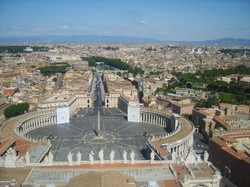The eremitical existence involves not isolation from others, but deep intimacy with God, for hermits spend much time in contemplative prayer and meditation. Contemplative prayer is the goal of all Christian prayerfulness.This is a kind of prayer in which the individual praying comes into the divine presence and rests in it, often silently and rapt in the act of worship.Christian meditation differs from the kind popularized by Hindus and Buddhists, for it involves reflecting on Scripture or religious concepts. Yet Christian hermits cannot cut themselves off from contact with others, for they can be called from their solitary life in the cause of duty, and they cannot refuse if they are to be true to their Christian calling.Pope Celestine the Fifth [1215-1294] was a saintly hermit called from his quiet existence to be pope, a position he accepted unwillingly out of duty. He reigned five months before abdicating, only to be imprisoned by his successor, Boniface the Eighth, dying quietly two years later in the castle where he turned his cell into a hermitage.
Hermits eschew social contact, but not totally. Sister Wendy Beckett, an English nun and art expert, dwells in a caravan in the grounds of a convent of Carmelite nuns in the South of England, where she speaks only to two nuns, the mother superior and the nun who brings her the daily provisions. but when she was delivering a television series on the history of Art, a subject in which she is an expert, she spoke fluently and long to the cameras. Wendy, who studied at Oxford where she obtained the highest marks ever achieved in an English degree, recognizes that she must talk when necessary. She also has to join with other nuns to attend daily mass. But beyond this she lives and works alone.
Like all members of Catholic religious orders hermits must work for their living, and Wendy does this by spending two hours a day putting her first class academic brain to use by translating Latin manuscripts or by writing books on the history of Art.
Another nun who was for many years a hermit on the Lleyn Peninsula of Wales was Verena Schiller, but eventually she had to accept the medical limitations of old age and return to communal living in a small convent with some like minded sisters. She wrote of her experiences in a lovely book, A Simplified Life.Verena relished the quietness of the Lleyn and its beauty,which added to her prayer life, gave her added strength to cope with her way of life.She seems to have suffered none of the crises that some of the hermits cited earlier on suffered.
Some Catholic groups attempt to combine the eremitical life with the communal life. One such group are the Carthusians, parallel orders of males and females who dwell in monasteries, but each in their own cell, where they live lives of prayer and study. You can purchase a book titled Interior Prayer by A Carthusian. They use their scholarship to produce writings, but never in their own names. All their books have the same author, A Carthusian. They spend two hours a day gardening for exercise and to produce their own food.The lifestyle involves wearing hair shirts for penance, and while they eat silently together and share in collective worship they have a limited period of socialization once a week. All the Carthusian hermits are ordained priests, but there are unordained brothers who live in community and perform the routine tasks of the monastery.










 Pilgrimage. A review16 days ago
Pilgrimage. A review16 days ago
 Leo the Fourteenthon 05/09/2025
Leo the Fourteenthon 05/09/2025
 The Melsonby Hoardon 03/25/2025
The Melsonby Hoardon 03/25/2025



Comments
Brother Antony is an allusion to Antony the Abbot, who was Egyptian.
Thank you for your comment below in answer to my previous observation and question.
So Brother Antony is Antony of Lérins (468?-520?), correct?
Is it your detail or his observation about the new-looking footwear of a traveler whose footwear therefore should show wear-and-tear?
Antonybwas the saintly hermit who had some grim visits from demons, but I won't write about thevecperiences on a family website.
Yes, I did recognize in your Genius loci the very same temptations of Jesus Christ.
This compelling short story interests and intrigues me with its effectivest characterizations, context, language, length and plot. (It invokes the regret that there is no Pontius Pilate novel ;-{!)
That it involves a Brother Antony invites the question: why Antony?
To return at the appointed time is in the temptations of Christ in Luke's Gospel. Yes I'll be back is apt. Did you see the temptations of Christ in this story?
Thank you for Genius loci.
The aforementioned short story is compelling even as it invokes the scariness of being on one's own away from all worldly help in times of other-worldy and worldly troubles and the unsettling presence of a walker with "surprisingly clean" boots.
It's an effective ending even as I ponder, without wishing for words other than St. Luke's wending their way through the conclusion, how one would say "to return at the appointed time."
What would "appointed time" mean in St. Luke's gospel?
(Would it be the equivalent of that famous line from the Arnold Schwarzenegger Terminator film, "I'll be back"?)
I searched through my documents to findvthevonline version. But I am going to bed soon, so I will send it to you tomorrow, but could you message me your e-mail address.
Yes, it appeals to me to avail myself of Genius loci, which I have not read or seen anywhere thus far.
May you find the original writing!
Otherwise, if not, will it not be too time-consuming to rewrite it?
Thanks.
Best wishes -- with Nathan Pacheco's voice so strong, in Be Thou my vision, that it achieves ;-D sound waves all the way to you and Maureen and your family and to Veronica and her husband and their family -- with physiotherapy!